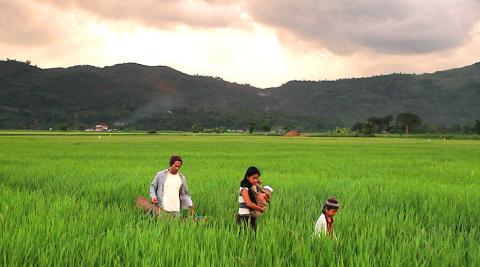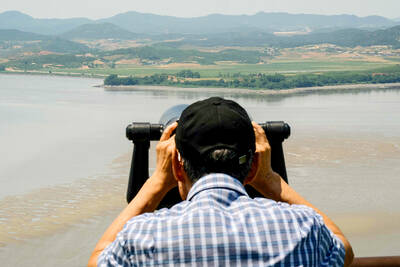Britain’s nominee as Best Foreign Language Film for the Oscars features an all-Filipino cast and a story that traces the sacrifices and hopes of an impoverished family from the countryside that tries its luck in the dark and squalid ghettos of the Philippine capital Manila.
Metro Manila, written and directed by Briton Sean Ellis, is one of three foreign language films nominated in the best foreign language category for next year’s Oscars which delves into the lives of Filipinos.
The Philippines’ nominee Transit focuses on the struggles of migrant Filipino workers in Israel, while Singapore’s entry Ilo Ilo is about a Filipino nanny who works for a Singaporean family.

Photo: AFP
The US film academy will select the finalists in January ahead of the Oscar ceremony on March 2.
“I thought it was a very beautiful and poetic story about family and about sacrifice and about hope,” Ellis said of his movie, which won an audience award at the recent Sundance Film Festival. The movie premiered in Manila last week and opens in Philippine cinemas on Wednesday.
It tells of the journey of farmer and former soldier Oscar Ramirez, played by veteran stage actor Jake Macapagal, and his young family from the rice terraces in the rural north of the country to the chaos of Manila to seek a better life.

Photo: AFP
In the city, they fall prey to various characters and are forced out of desperation to make difficult choices. Oscar’s wife, Mai, played by film actress Althea Vega, is forced to become a bar girl to feed her two young children.
Oscar manages to land a job as a driver for an armored truck company and is befriended by Ong, his senior officer. Ong — played by John Arcilla — is helpful and jolly, but it becomes clear he had been waiting for someone naive and trusting like Oscar to come along.
Ellis said the story was inspired by a scene he witnessed while visiting the Philippines. Two employees of an armored truck company, in bulletproof jackets and helmets, and lugging M16 rifles, were screaming at each other. It ended with one of them kicking the truck before they both got in and drove off.
He said the scene remained with him when he returned to Britain and he kept on wondering what they were arguing about. That led him to develop a 20-page synopsis. He then flew to Los Angeles to flesh out the script with his friend Frank E. Flowers.
The script was in English, but Ellis allowed the actors to translate their lines into Tagalog.
Ellis said it was strange to direct a movie in a language he could not understand, but for only “about five seconds, because then you start to see the performance and you’re not worried about the words they’re saying, you trust them to say the words that are in the script.”
Macapagal, 47, who spent a decade in Europe working in the musical stage production Miss Saigon, said the role was “challenging but not very far from every Filipino’s plight.” Macapagal said he could easily relate to Oscar’s life because he does not come from a privileged background.
Manila’s dark side has been explored in several films by Filipino directors, including the classic 1975 film Manila, in the Claws of Light by the late award-winning director Lino Brocka, and more recently by noted director Brillante Mendoza.
“There’s a texture in our city that we don’t normally see because there are times we numb ourselves to the poverty,” Macapagal said, adding Ellis “looks at things you don’t normally look at.”
Arcilla said the poverty shown in the movie can be found in slums in many countries. “For me it’s not really about poverty, its more on human survival and more on human sacrifice,” he said.
Vega, 25, said it was a story about taking chances and making desperate choices to survive.

In the next few months tough decisions will need to be made by the Taiwan People’s Party (TPP) and their pan-blue allies in the Chinese Nationalist Party (KMT). It will reveal just how real their alliance is with actual power at stake. Party founder Ko Wen-je (柯文哲) faced these tough questions, which we explored in part one of this series, “Ko Wen-je, the KMT’s prickly ally,” (Aug. 16, page 12). Ko was open to cooperation, but on his terms. He openly fretted about being “swallowed up” by the KMT, and was keenly aware of the experience of the People’s First Party

Aug. 25 to Aug. 31 Although Mr. Lin (林) had been married to his Japanese wife for a decade, their union was never legally recognized — and even their daughter was officially deemed illegitimate. During the first half of Japanese rule in Taiwan, only marriages between Japanese men and Taiwanese women were valid, unless the Taiwanese husband formally joined a Japanese household. In 1920, Lin took his frustrations directly to the Ministry of Home Affairs: “Since Japan took possession of Taiwan, we have obeyed the government’s directives and committed ourselves to breaking old Qing-era customs. Yet ... our marriages remain unrecognized,

During the Metal Ages, prior to the arrival of the Dutch and Chinese, a great shift took place in indigenous material culture. Glass and agate beads, introduced after 400BC, completely replaced Taiwanese nephrite (jade) as the ornamental materials of choice, anthropologist Liu Jiun-Yu (劉俊昱) of the University of Washington wrote in a 2023 article. He added of the island’s modern indigenous peoples: “They are the descendants of prehistoric Formosans but have no nephrite-using cultures.” Moderns squint at that dynamic era of trade and cultural change through the mutually supporting lenses of later settler-colonialism and imperial power, which treated the indigenous as

Standing on top of a small mountain, Kim Seung-ho gazes out over an expanse of paddy fields glowing in their autumn gold, the ripening grains swaying gently in the wind. In the distance, North Korea stretches beyond the horizon. “It’s so peaceful,” says the director of the DMZ Ecology Research Institute. “Over there, it used to be an artillery range, but since they stopped firing, the nature has become so beautiful.” The land before him is the demilitarized zone, or DMZ, a strip of land that runs across the Korean peninsula, dividing North and South Korea roughly along the 38th parallel north. This